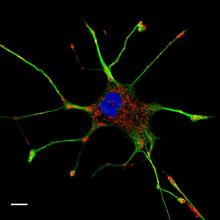Friend of the lab Jeff Lichtman describes some of the core principles of microscopy in these videos from the fine folks at iBiology.org.
Diffraction
Description: Light has properties of particles and waves. Understanding the wave nature of light is essential to understanding the workings of a microscope. This lecture describes Huygens Wavelets, constructive/destructive interference, and diffraction.
Point Spread Function
Description: An infinitesimally small point appears in the microscope as a spot with a certain size, blurred in the z-direction and with concentric rings around it. This "point spread function" reveals many of the optical properties of your microscope. This lecture explains why and how the microscope images a point as a point spread function.
Resolution/sampling
Description: The resolution of a microscope can be defined as the smallest distance at which two small objects can still be seen as separate objects. This lecture discusses various criteria for resolution, the factors that influence resolution in the lateral and axial planes, and how to sample an image adequately using a camera or confocal microscope, such that the full optical resolution is retained.
